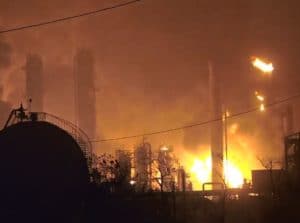Federal report analyzes possible cause of TPC explosion amid litigation
Federal report analyzes possible cause of TPC explosion amid litigation

One year after the explosions, litigation is in early stages, with pre-trial hearings happening jointly in Orange County, which allows lawyers on both sides to talk about logistics.
This week, TPC Group said the company has settled more than 5,000 homeowner claims under the voluntary claims program and reimbursed more than 18,800 residents for evacuation expenses.
What caused the TPC explosion? The questions have gone unanswered, but a federal report released last month offered crucial clues about what went wrong last year.
The U.S. Chemical Safety Board released a 13-page report detailing the timeline of what led up to the TPC explosion. The report does not state the root cause, but it helps explain what happened.
After the TPC explosions unleashed chaos and confusion in Mid County one year ago, federal officials now have a better idea of what went wrong.
Abut 6,000 gallons of liquid vapor, mostly butadiene, escaped from one of the processing towers at the TPC Group plant in Port Neches. Then two minutes later, the plant was on fire.
Attorney Eric Newell with Brent Coon and Associates is representing victims of the TPC explosion.
“One of the main things that we were gonna be looking at early on was the popcorning in the pipes,” he said last month when the report was initially released.
Industrial workers are familiar with the term popcorning, which is when popcorn polymers form in equipment from oxygen and butadiene reacting.
Eight days before the explosion, TPC Group installed temporary filters to catch any popcorn polymer chunks, the report stated.
TPC Group maintains it is too early to know the exact cause.
However, the facility in Port Neches also had a history of air quality violations, according to the EPA. TPC Group was fined $275,000 over the past 10 years.
In one case, state regulators cited corrosion, which was an issue mentioned in several violations, on a butadiene transfer line as the source of a leak.
The TPC Group plant was also non-compliant with the Federal Clean Air Act in every quarter since January 2017.
search
our offices
FROM THE BLOG
Texas A&M donors’ lawsuit against 12th Man Foundation over Kyle Field seats and parking to proceed
By David Barron, Correspondent A Brazos County state district judge has cleared the way for a long-delayed trial showdown between a group of disillusioned Texas A&M donors and the A&M-affiliated 12th Man Foundation, stemming from a decade-old dispute over seating and parking rights at Kyle Field. State District Judge George Jerrell Wise on Wednesday signed an order denying a summary…
Lawsuit Against Texas A&M Aggies 12th Man Foundation Moves Forward
A legal showdown between former Texas A&M donors and the 12th Man Foundation will proceed at last. A Brazos County judge has ruled that a lawsuit between former Texas A&M Aggies donors and the 12th Man Foundation will move forward, David Barron of the Houston Chronicle reports. On Wednesday, State District Judge George Jerrell Wise…
Texas A&M donors’ lawsuit against 12th Man Foundation over seating, parking dispute cleared for trial
A group of Texas A&M donors will finally get their day in court for a dispute against the 12th Man Foundation over parking and seating at Kyle Field. According to the Houston Chronicle, a judge in Brazos County last week denied a summary judgment motion from the 12th Man Foundation, which sought to dismiss the…


